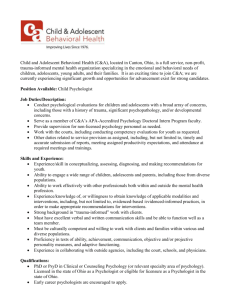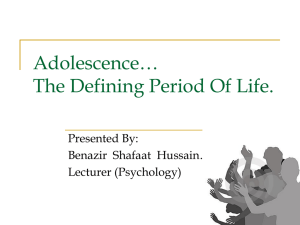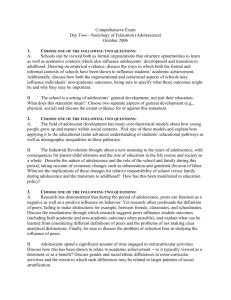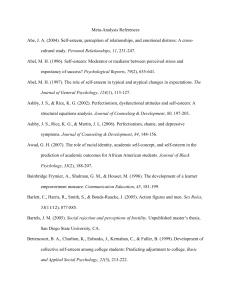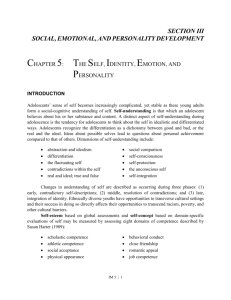CHAPTER 5:
advertisement
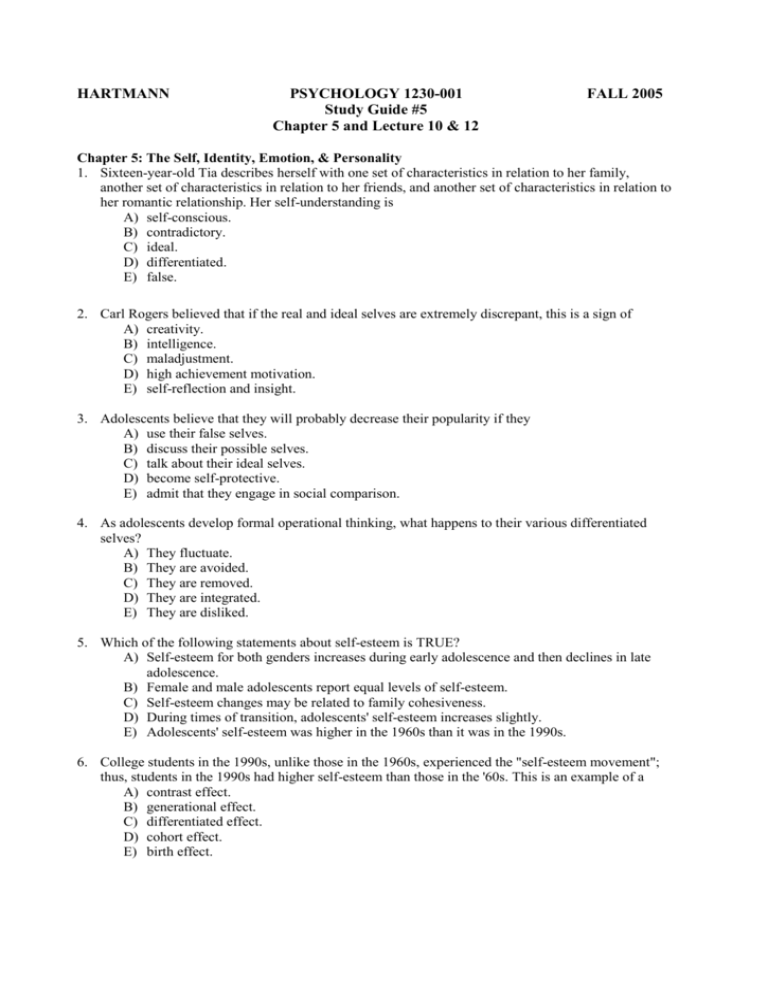
HARTMANN PSYCHOLOGY 1230-001 Study Guide #5 Chapter 5 and Lecture 10 & 12 FALL 2005 Chapter 5: The Self, Identity, Emotion, & Personality 1. Sixteen-year-old Tia describes herself with one set of characteristics in relation to her family, another set of characteristics in relation to her friends, and another set of characteristics in relation to her romantic relationship. Her self-understanding is A) self-conscious. B) contradictory. C) ideal. D) differentiated. E) false. 2. Carl Rogers believed that if the real and ideal selves are extremely discrepant, this is a sign of A) creativity. B) intelligence. C) maladjustment. D) high achievement motivation. E) self-reflection and insight. 3. Adolescents believe that they will probably decrease their popularity if they A) use their false selves. B) discuss their possible selves. C) talk about their ideal selves. D) become self-protective. E) admit that they engage in social comparison. 4. As adolescents develop formal operational thinking, what happens to their various differentiated selves? A) They fluctuate. B) They are avoided. C) They are removed. D) They are integrated. E) They are disliked. 5. Which of the following statements about self-esteem is TRUE? A) Self-esteem for both genders increases during early adolescence and then declines in late adolescence. B) Female and male adolescents report equal levels of self-esteem. C) Self-esteem changes may be related to family cohesiveness. D) During times of transition, adolescents' self-esteem increases slightly. E) Adolescents' self-esteem was higher in the 1960s than it was in the 1990s. 6. College students in the 1990s, unlike those in the 1960s, experienced the "self-esteem movement"; thus, students in the 1990s had higher self-esteem than those in the '60s. This is an example of a A) contrast effect. B) generational effect. C) differentiated effect. D) cohort effect. E) birth effect. Psychology 1230-001 (Hartmann) Study Guide #5, p. 2 of 6 7. Why does classmate support contribute more strongly to adolescents' self-esteem than close-friend support? A) Because classmate support translates into better grades. B) Because close friends come and go. C) Because there are far more classmates than close friends. D) Because classmates include both genders, whereas close friends are just one gender. E) Because classmates are perceived as more objective sources of support. 8. What are two core ingredients in Erikson's theory of identity development? A) secure and insecure exploration B) crisis and commitment C) personality and role experimentation D) individuality and connectedness E) intimacy and isolation 9. Some contemporary theorists believe that during adolescence, identity development is more characterized by the search for balance between the two needs of autonomy and A) independence. B) conformity. C) superiority. D) commitment. E) connectedness. 10. Which of the following is a criticism of Marcia's theory of identity statuses? A) It is too research oriented. B) It ignores individual differences. C) There is questionable reliability of assessment. D) It distorts and trivializes Erikson's ideas about crisis and commitment. E) all of these 11. Marcia suggests three important aspects of adolescent identity formation: (a) confidence in parental support, (b) a self-reflective perspective on the future, and (c) A) flexibility. B) social reciprocity. C) intimacy. D) a sense of industry. E) high self-esteem. 12. If adolescents have strong mutuality and permeability, yet weak self-assertion and separateness, they often have identity A) diffusion. B) moratorium. C) achievement. D) development. E) foreclosure. 13. According to the text, most ethnic minority individuals consciously confront their ethnicity for the first time in A) early childhood. B) middle childhood. C) adolescence. D) early adulthood. E) middle adulthood. Psychology 1230-001 (Hartmann) Study Guide #5, p. 3 of 6 14. In African American and Latino adolescents fewer behavior problems and greater school engagement has been found to be associated with A) an easy temperament. B) the personality traits of extraversion and openness. C) all big five factors of personality. D) a strong ethnic identity. E) all of these 15. Neftali is in the internalization/commitment stage of Helms' ethnic identity development theory. Which of the following behaviors is he most likely to exhibit? A) anger at the White majority culture B) preference for the White majority culture and dislike of his ethnic minority culture C) total involvement in an Arab-American organization and rejection of the majority culture D) guilt over his previous endorsement of the majority culture E) involvement in civil rights groups to help combat discrimination 16. According to Orlofsky, in what style of intimate interactions does the individual show mixed emotions about commitment, which is reflected in the strategy of offering love without obligation or long-lasting bonds? A) emotional style B) pseudointimate style C) stereotyped style D) isolated style E) preintimate style 17. Jake and Pat have been in a relationship for two years that is primarily sexual in nature, with little depth or closeness. According to Orlofsky, what is their style of intimate interaction? A) isolated style B) emotional style C) pseudointimate style D) stereotyped style E) preintimate style 18. Jordan is experiencing many emotional highs and lows. According to research, it is most likely that Jordan is A) a girl. B) a boy. C) in early adolescence. D) in late adolescence. E) an only child. 19. Researchers have found that from the 5th through 9th grades both girls and boys experience a ______________ decrease in the state of being "very happy." A) 10% B) 25% C) 50% D) 75% E) 90% 20. The temperament classification of negative affectivity is closely related to the personality traits of A) introversion and conscientiousness. B) irritability and slow-to-warm-up. C) effortful control and neuroticism. D) openness and irritability. E) neuroticism and introversion. Psychology 1230-001 (Hartmann) Study Guide #5, p. 4 of 6 21. Question no longer used: Studies have found that mothers who are low in adaptability have more conflict with sons when the sons are low in activity, but more conflict with daughters when the daughters are high in activity. According to the text, why might this be? A) Less adaptable mothers have conflict with their children, no matter how active the children are. B) Gender role stereotypes affect how the mothers interpret their children's behavior. C) Highly active daughters are usually delinquent and inactive sons are usually drug addicted. D) Mothers with low adaptability also tend to have high levels of neuroticism. E) Highly active daughters and less active sons cause their mothers to develop low adaptability. Discussion Questions: 1. Describe the following two conceptual approaches to understanding the self, and give an example from your own experience: looking glass self and similarity assumption. 2. Identify and describe changes in the understanding of self during adolescence and explain how self-understanding is influenced by sociocultural contexts. 3. How do family, culture, ethnicity, and gender influence developmental changes in identity formation during early and late adolescence? Lectures 10 & 11: 1. _______________________ is both an area within psychology involving cognitive development and social phenomena, and a mediator between socialization experiences and social actions. A. Cognitive disequilibrium B. Cognitive psychology C. Social psychology D. Social cognition E. None of the above. 2. Which sense of self is viewed as our understanding of what other think of us—what they say about us and act towards us. A. The similarity assumption B. The looking-glass self C. I D. Me E. Mahler’s chicken in egg. 3. A. B. C. D. E. According to William James, a very important early self theorist, the “I” is the part of self that is closely akin to the superego is the target of reflection is unconscious is the doer and the knower controls emotions 4. In many Asian and Latino cultures, responses to the “Who am I?” test—which measures self conception—contain many more _______ statements than in the US non-Latino white culture. A. critical B. relational C. guilty D. individualistic E. none of the above 5. The best estimate of the course of self-esteem across development, according to the lecture, is that there is a(n) _________ in adolescence. Psychology 1230-001 (Hartmann) Study Guide #5, p. 5 of 6 A. B. C. D. E. 6. spiraling increase leveling off drop none of the above The personal fable and imaginary audience are both examples of A. components of self regulation B. interpsychic events related to the development of the id C. mental illness D. egocentric thinking E. none or all of the above 7. Susan Harter demonstrated it in her work in self-esteem, but it is true in other domains of psychology as well: As we age we increasingly become A. Cranky B. More intelligent C. Splitters D. Better spitters E. Gloppers 8. A. B. C. D. E. As we age, our descriptions of others become increasingly Concrete Adhering Repressive Psychological Spiritual 9. Elkinds concept of _____________ might help to explain why someone would say “I didn’t think a girl like me could get pregnant,” when asked why she engaged in unprotected sex. A. Imaginary audience B. Personal fable C. Pre-operational thought D. Self-efficacy expectations E. Oral personality 10. “The ability to assume another person’s perspective and understand his or her thoughts and feelings” is a common definition of A. social information processing B. social cognition C. social perspective taking D. reflection E. reciprocal determination 11. The psychologist whose name is most closely associated with the development of identity is A. William James B. Albert Bandura C. Sigmund Freud D. Erik Erickson E. Susan Harter 12. Marcia’s operationalization of identity theory posited that ______________ and commitment were critical components. A. Moratorium B. Diffusion Psychology 1230-001 (Hartmann) Study Guide #5, p. 6 of 6 C. Crisis D. Achievement E. Sex 13. The following comment is likely to have been uttered by someone is in the ___________ category of identity resolution: “I've never really questioned my religion. If it's right for my parents, it must be right for me.” A. Moratorium B. Diffusion C. Crisis D. Achievement E. Foreclosure 14. According to Adams’ research on the four types of identity classification, the individuals who seem to be in the best psychological shape are individuals who have either achieved there identity or are in _________________. A. Diffusion B. Foreclosure C. Moratorium D. Denial E. The depth of depression





